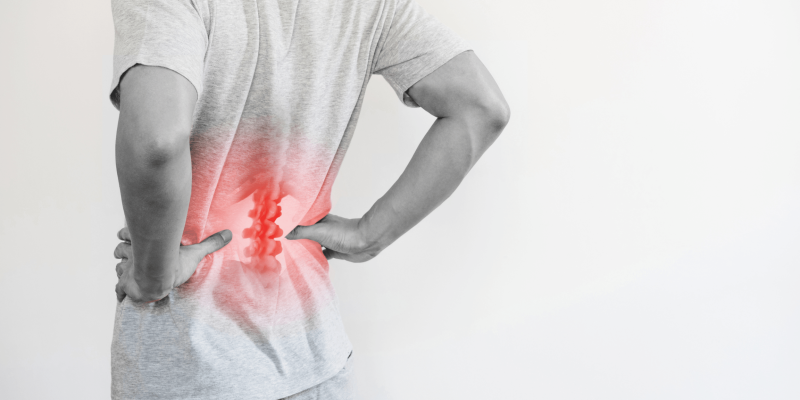If you’ve been sidelined by a sore back, you’re not alone. Four out of five people experience back pain at some point, making it the second most common reason for visiting the physical therapist. Although determining the cause of back pain can be complicated, there are many different actions you can take to help improve lower back pain.
In this routine, I have shared with you 4 important steps that help you to improve your lower back pain, especially if you experience chronic lower back pain. This routine can also help you to minimize the recurrence of back pain. For gaining the optimum results, this routine has to be followed daily as part of your weekly plan.
Step number 1: Stay active
Being active not only can help you to improve your lower back pain, but it also can reduce your chances of getting back pain.
The research highlighted “Aerobic exercise can benefit chronic lower back pain as it increases the blood flow and nutrients to the soft tissues in the back, improving the healing process and reducing the stiffness that results in back pain. Surprisingly, a low aerobic fitness level is associated with chronic lower back pain (Read more).
In addition, 30–40 min of any aerobic exercise increases the body’s production of endorphins (Happy Hormone). “A brain chemical that binds to the opiate receptors in the pain control system in the brain and spinal cord to decrease the perception of pain” (Read more).
Endorphins act in a similar way to “pain-reducing drugs” such as morphine and codeine. However, increasing the body’s endorphin production is a natural alternative for pain relief for the body and can reduce chronic lower back pain (Read more).
What is aerobic exercise?
Aerobic exercise is any type of cardiovascular conditioning. It can include activities like brisk walking, swimming, running, or cycling. You probably know it as “cardio”. By definition, aerobic exercise means “with oxygen.” Your breathing and your heart rate will increase during aerobic activities.
Step number 2: Monitor Your Sleep Quality
Poor sleep is known to cause a range of physiological and psychological effects. Over the long term, these effects can become severe and lead to serious health conditions such as depression, obesity, type-2 diabetes, hypertension, and coronary artery disease. “A recent study found that lower back pain patients who reported sleep disturbance were twice as likely to be hospitalized compared with those who did not (Read more).
Chronic low back pain is often associated with poor quality of life, negative affect, and functional impairment. Many people with chronic pain conditions also endorse poor sleep quality (Read more). In addition, research has shown consistently a link between poor sleep quality to greater pain intensity in adults with lower back pain.
Step number 3: Follow A healthy diet
Research has shown poor diet as one of the lifestyle risk factors that contribute to the burden of low back pain. They have included, individuals with excess weight, physical inactivity, poor diet, and smoking have a higher risk of experiencing lower back pain (Read more). In addition, poor diet and its consequences like overweight and obesity are the common healthy problem in urban societies.
A meta-analysis showed that both overweight and obesity increase the risk of lower back pain. Overweight and obesity have the strongest association with seeking care for low back pain and chronic lower back pain (Read more).
The research suggested, a significant part of poor diet and weight management may involve restructuring the environment that promotes overeating and under activity. The environment includes the home, the workplace, and the community (e.g., places of worship, eating places, stores, movie theaters).
In addition, busy lifestyles and hectic work schedules create eating habits that may contribute to a less than desirable eating environment, but simple changes can help to counteract these habits (Read more).
Step number 4: Don’t neglect Resistance Training
For many years, “resistance training has been recognized for its value in improving the health and performance of athletes and other healthy persons. However, recently has scientific evidence emerged that relates to its benefits in the prevention and rehabilitation of chronic diseases and medical conditions such as arthritis, pulmonary disorders, and heart disease” (Read More).
Resistance (strength) training has been shown to result in increases in helping patients to get back to the normal activities of daily living—sitting, rising, bending, twisting, lifting, walking, and climbing—by enhancing strength, flexibility, endurance, and balance (Read More). That means, with getting stronger you can improve your quality of living, and specifically if you experience back pain it can be part of your rehabilitation/prevention routine.
Research has shown vigorous physical activity beneficial for intervertebral disc health. They highlighted those participants with any amount of daily vigorous physical activity have better disc health than those without vigorous activity (Read More). In addition, participants with greater than 30 minutes of daily moderate to vigorous physical activity have better disc health when compared to participants with less than 30 minutes of daily moderate to vigorous activity.
Step number 5: Acute Pain vs Chronic Pain
Acute Pain vs Chronic Pain As we know acute pain is short term & tend to be more associated with damage or possible damage to tissue. For instance, ankle sprain & you will experience pain, bruised and swelling. Healing takes less than 3 months even for quite severe injuries. (Read more: Healing Stage following soft tissue injuries).
In comparison, chronic pain (Chronic Pain Development) lasts longer than acute pain and often does not indicate ongoing tissue damage, even though it may feel like it. “Pain is less to do with injury in his our bodies and more to do with our central nervous system it’s like the volume knob on our pain system has been left turned up like a radio stuck on ‘loud’ persistent pain can take over a person’s life it’s really important to understand that you can ‘turn the volume down’ again, but it often takes effort and time.
In summary, Chronic Lower back pain is the fifth most common reason for physician visits, which affects nearly 60-80% of people throughout their lifetime. However, your lifestyle and your daily habits such as understanding your pain, being active, having a good night’s sleep, following a healthy diet, and apply resistance training in your routine, can influence your quality of living and help you to minimize your chances of experiencing lower back pain.
In Dublin Sports Injury Clinic we see a vast majority of patients with lower back pain, and we help those individuals with pain education and prescribed exercise and rehabilitation routine. If you experience back pain or you would like to prevent back pain you can contact us and we will assist you with a customized treatment and training routine that suits you and improve your lower back pain.
PS. We are not claiming with following this routine you will not going to experience back pain. Back pain is multifactorial and if you experience back pain, make sure to contact your physical therapist for optimum results.
Our Approach
Dublin Sports Injury Clinic is a physical therapy clinic based in Pearse Street, Dublin 2. We have a high volume of patients who are treated with low back pain. Initially, our treatment will be focusing on helping our patients to get pain free as quickly as possible. We educate our patients to understand the cause of their back pain and how they can stay pain-free. Rehabilitation exercises will be customized for every patient and we show them the correct techniques and progression.
FOLLOW US ON YOUTUBE AND GET ACCESS TO OUR WEEKLY FREE REHABILITATION EXERCISES.
Next step
Want to get in touch with our team of a therapist or you are looking for some advice? Simply fill in your details below & we get in touch with you shortly.
Disclaimer: This article is for information only and should not be used for the diagnosis or treatment of medical conditions. You can contact us if you would like to book an appointment or get some advice from our therapist.

